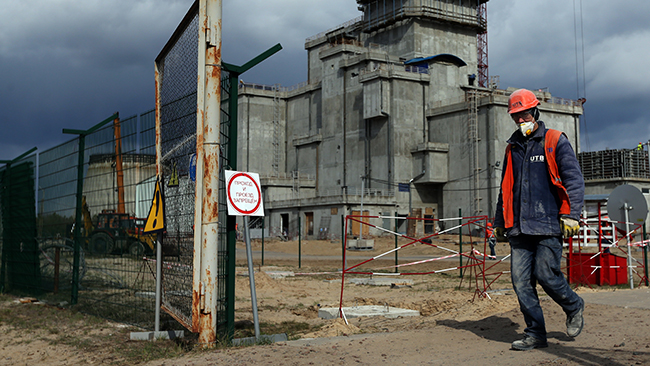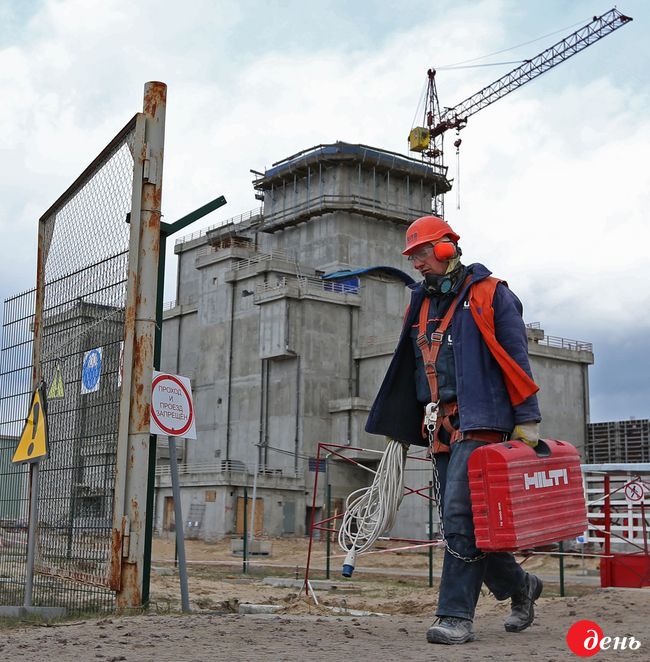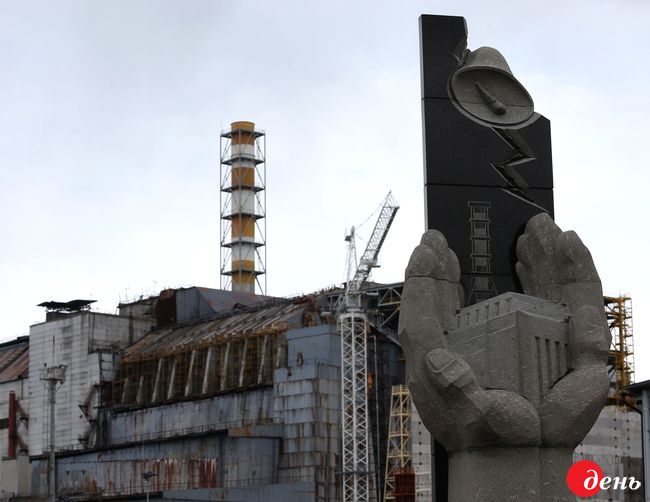Grand construction in exclusion zone
Den’s reporters examined what and why is built around Chornobyl Nuclear Power Plant
People are standing at “Dytiatky” checkpoint on the border of the Chornobyl exclusion zone. They are the former local residents, who came here on the cemetery memorial day. However, the exclusion zone is more than just a graveyard for people, houses, and dreams – it is also a grand construction site.
Communal workers in orange vests are busy tinting the borders near the power plant with white paint – they do this every spring. The territory is clean. The landscape is dominated by a semicircular nuclear confinement, which is being built around the Fourth Reactor. The building, managed by a French company Novarka, will be completed on November 20, 2017. On the site, there are workers from 17 countries, taking 15-day watches at work, followed by 15 days of rest. The daily shifts are seven or eight hours. No one lives in Chornobyl, the workers commute from surrounding cities – for instance, Slavutych.
The new confinement will enclose the original sarcophagus, built in 1986. The old shelter, which can be used up to 2023, will be dismantled after the new one is built. The construction will come in two stages — firstly, the arch will be built, and then the dismantling of the underlying structure will start. There is a strategy on how to approach to this task, but the detailed project has not been laid out yet.
The confinement will be good for 100 years of use. “We will have 50 years to solve the problem of the geological storage, to remove nuclear fuel from the site, and to devise a strategy on how to disassemble the object completely. The following 50 years we will have to fulfill that strategy,” says Volodymyr Kashtanov, chief engineer of the project “Implementation of procedures on Shelter site.”
The new sarcophagus will stand on concrete pillars, each 25 meters long and one meter in diameter. The foundation will be eight meters in height. The confinement facility will cost 2 billion Euros, 1.5 of which are for the shelter building itself. The money was allocated by Chornobyl Shelter Fund, managed by the European Bank for Reconstruction and Development. The fund has many countries as investors, including Ukraine, which provided around 150 million euros for the project.

BEHIND THE WORKER’S BACK IT THE PREMISE THAT IN A FEW YEARS WILL PREPARE THE SPENT NUCLEAR FUEL FOR STORAGE
The buildings, designed for keeping nuclear waste, are scattered, like child’s toys, on the green glades near Prypiat. They compose the “Vector” Centralized Nuclear Waste Storage. The infrastructure is already laid out – there will be a fire station, biological ponds, water reservoirs, a dining facility, and six storage facilities. One such facility is already operational – as well as the fire station and the checkpoint with the dosimetry monitoring. A “cold test” – that is, one without the actual nuclear waste – has been performed on another storage building.
The narrow metal stairs lead to the observation platform, from which the functioning storage can be seen. The bottom floor is divided into honeycomb-like cells, in which 29 “portions” of waste from Chornobyl power plant are stored – before that they were stored in a specialized facility in Kharkiv. The storage building will contain four tiers – as soon as there is no room on the first one, it will be cast in concrete, and the second tier will be placed on top of it. Once all four tiers are full, the building will be engulfed in concrete, and then covered with ground, clay, and black soil, on which grass will be planted. The storage is good for 300 years of waste-keeping.
The construction of different “Vector” departments will be finished from 2017 to 2020. It will accept nuclear waste from Chornobyl and three other working nuclear plants: South Ukraine, Rivne, and Khmelnytsky. The other power plant, in Zaporizhia, has its own nuclear waste storage facility.

HOPEFULLY, THE “PEACEFUL ATOM” IS IN THE GOOD HANDS TODAY. THE FOURTH CHORNOBYL UNIT IS IN THE BACKGROUND
Failure to meet the construction deadline can cost us several dozen million dollars in a fine from Russia. The reason is that we must return the spent fuel from our nuclear plants to the countries we took these resources from, Russia in particular. Thus, the spent fuel is cooled down and sent via the railway to Russia, where it will be utilized. The glazed leftovers of the process must be returned to the country that used up the fuel – that is, to us. And according to the latest agreement, we will start to receive it in 2018.
“Vector” will also accept new radioactive waste from all over Ukraine. Various contaminated scrap of different origin, radiation level and half-life cycle can be stored here, kept within stainless steel cases, enclosed in lead.
Eventually, the high radioactivity waste with a long half-life period, will be placed for good into a geological storage. “As for the geological storage, we have only surveyed the possible locations, not much work has been done further. There are three spots within the exclusion zone, and we will choose the location among them,” says Valentyn Melnychenko, Director General of Radon governmental association, which deals with all the radioactive waste in the country.
A “castle” with cubic protrusions is the future Shelter for Spent Nuclear Fuel mk.2 (SSNF-2), which will accept the waste from the first, second, and third units of Chornobyl power plant. The building will be finished in 2017. In 1999, when the construction had started, various French companies had been managing it, but the technology implemented was not very suitable for this project – and the object stood frozen for several years in early 2000s. Nowadays, the construction is carried on by an American company Holtec, which employs Ukrainian workers here.

A NEW SARCOPHAGUS WILL STAND HERE. THE GRAND ARCH IS THE SECOND SHELTER FOR THE FOURTH REACTOR OF CHORNOBYL NUCLEAR POWER PLANT
The site is surrounded by a fence, inside are the busy workers, excavators and cranes. After the project is finished, the spent fuel (in the form of heat-emissive assemblage) will be brought here via the railway. Here, the assemblages will be divided in halves that will be stored in the special cartridges, which, in turn, will be buried in the canisters. The cartridges and canisters are manufactured in US; the pilot batch of the product was tested past summer.
The full canisters (each containing 196 assemblage halves) will be dried – then the inside partitions will be sealed and the special gel will be pumped inside; afterwards, the outside cover will be sealed by welding and the impermeability will be tested. All this will happen in the castle-like facility, and then a cart will take the spent fuel to the concrete storage cells.
At the moment, the fuel from the three Chornobyl power plant units is stored in the SSNF-1, which had been built in 1986 on the plant’s territory. Around 21,000 heat-emissive assemblages are being cooled inside the water pools. It will take nine years to transport them inside the new shelter. And the separate project of decommissioning SSNF-1 is also yet to be considered.
The canisters in the new shelter are double-walled, designed for one hundred years of usage. Special equipment is installed to check the canisters’ integrity from time to time, as well as the radioactivity sensors around the site. The project will cost around 300 million euros. Andrii Savin, SSNF-2 chief construction engineer on the customer’s part (that is, the representative of Chornobyl power plant) has told The Day, that the funds will come from the Nuclear Safety account of the European Bank for Reconstruction and Development. The costs of running the facility will be covered by Ukraine.
And there is also the question of storing the spent nuclear fuel from other plants in Ukraine. As was mentioned before, only Zaporizhia Nuclear Plant has the necessary infrastructure. The construction of the Centralized Shelter for Spent Nuclear Fuel has started on August 26, 2014. It is a project of “Enerhoatom” National Atomic Company and Holtec. This will be the place where the spent fuel from all the Ukrainian nuclear plants will go.
“There are three stages of building the Centralized SSNF,” said Ihor Orlov, director for the new nuclear facilities of AtomProjectEngineering Company. We chose the institute to complete the design project in 2016, and it will undergo an expertise in the same year. The construction is due in late 2017 or in early 2018. Early 2018 is the date when we want the first canister of spent nuclear fuel to be delivered here for storage.” This new facility will only accept Ukrainian fuel. After several dozen years will have passed, it will be decided whether to bury the site forever or to reconstruct it for further use.
P.S. Before leaving the exclusion zone we visited a former residential district of once-inhabited Chornobyl city. There we saw a funny man with an ice cream. The laughing man was wearing a blue overall. He has been working for three years at a car station near Chornobyl, receiving a lot of benefits for working in a contaminated zone, and he is completely happy. The exclusion zone lives, albeit peculiarly, but it lives.
Section
Society





